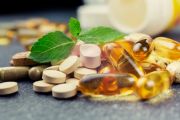Health benefits
Milk thistle acts in a similar fashion to detoxify other synthetic chemicals that find their way into our bodies, from acetaminophen and alcohol to heavy metals and radiation.
Milk thistle was approved in 1986 as a treatment for liver disease and it is widely used to treat alcoholic hepatitis, alcoholic fatty liver, cirrhosis, liver poisoning and viral hepatitis. It has also been shown to protect the liver against medications such as acetaminophen, a non-aspirin pain reliever.
Repairs cells and encourages cell growth
The active ingredient, or liver-protecting compound in milk thistle is known as silymarin. This substance, which actually consists of a group of compounds called flavonolignans, helps repair liver cells damaged by alcohol and other toxic substances by stimulating protein synthesis. By changing the outside layer of liver cells, it also prevents certain toxins from getting inside. Silymarin also seems to encourage liver cell growth. It can reduce inflammation (important for people with liver inflammation or hepatitis), and has potent antioxidant effects. Antioxidants are thought to protect body cells from damage caused by a chemical process called oxidation. Our Milk Thistle is not standardized to an exact amount (as it is made from pure dried natural herbs. Milk Thistle naturally contains about 70 - 80% Silymarin (and many other constituents thought to work in harmony).
This herb benefits adrenal disorders and inflammatory bowel syndrome, and is used to treat psoriasis (increases bile flow).
Milk thistle has some estrogen-like effects that may stimulate the flow of breast milk in women who are breast-feeding infants. It may also be used to start late menstrual periods. Milk thistle's estrogen-like effect may also have some usefulness for men with prostate cancer.
In animal studies and one small study in humans, milk thistle produced modest reductions in total cholesterol. However, these results have not been demonstrated in larger human studies.
This herb is a must for cleansing and for anyone with any sort of liver dysfunction or exposure to toxins.
Liver disease from alcohol
A comprehensive review by the U.S. Agency for Healthcare Research and Quality (AHRQ) recently identified 16 scientific studies on the use of milk thistle for the treatment of various forms of liver disease. A European standardized extract of milk thistle was used in most of the trials. Problems in study design (such as small numbers of participants, variations in the causes of liver disease, and differences in dosing and duration of milk thistle therapy) made it difficult to draw any definitive conclusions. However, five of seven studies evaluating milk thistle for alcoholic liver disease found significant improvements in liver function. Those with the mildest form of the disease appeared to improve the most. Milk thistle was less effective for those with severe liver disease such as cirrhosis. Cirrhosis is characterized by scarring and permanent, non-reversible damage to the liver. It is often referred to as end-stage liver disease.
Viral hepatitis
Despite the fact that milk thistle is widely used in the treatment of hepatitis (particularly hepatitis C), results from four viral hepatitis studies were contradictory. Some found improvements in liver enzyme activity while others failed to detect these benefits. None of the studies compared milk thistle with interferon or other medications for viral hepatitis.
Cancer
Preliminary laboratory studies also suggest that active substances in milk thistle may have anti-cancer effects. One active substance known as silymarin has strong antioxidant properties and has been shown to inhibit the growth of human prostate, breast, and cervical cancer cells in test tubes. Further studies are needed to determine whether milk thistle is safe or effective for people with these forms of cancer.
High cholesterol
One animal study found that silymarin (an active compound in milk thistle) worked as effectively as the cholesterol-lowering drug probucol, with the additional benefit of substantially increasing HDL ("good") cholesterol. Further studies in people are needed.





